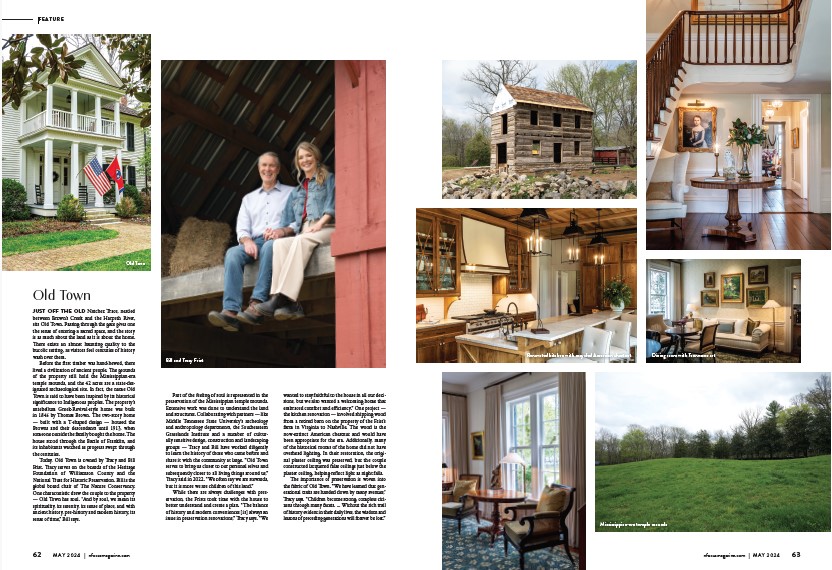Powered by
Issuu
Publish for Free
Old Town is featured in the May 2024 issue of nFOCUS, Nashville’s premier social and lifestyle magazine.
The article below is written by Janet Kurtz and photographs taken by Eric England. See full article below.
Elevating the Character of Space Through Historic Preservation

Old Town
Preservation has many faces. Depending on whether you’re preserving land or significant structures, the path to restoration can look very different. Some owners of historic homes choose to keep the building preserved and untouched. Others modernize the interior, while keeping the historic aesthetic of the exterior. Others fall somewhere in the middle.
JUST OFF THE OLD Natchez Trace, nestled between Brown’s Creek and the Harpeth River, sits Old Town. Passing through the gate gives one the sense of entering a sacred space, and the story is as much about the land as it is about the home. There exists an almost haunting quality to the bucolic setting, as visitors feel centuries of history wash over them.
Before the first timber was hand-hewed, there lived a civilization of ancient people. The grounds of the property still hold the Mississippian-era temple mounds, and the 42 acres are a state-designated archaeological site. In fact, the name Old Town is said to have been inspired by its historical significance to Indigenous peoples. The property’s antebellum Greek-Revival-style home was built in 1846 by Thomas Brown. The two-story home — built with a T shaped design — housed the Browns and their descendants until 1913, when someone outside the family bought the home. The house stood through the Battle of Franklin, and its inhabitants watched as progress swept through the centuries.
Today, Old Town is owned by Tracy and Bill Frist. Tracy serves on the boards of the Heritage Foundation of Williamson County and the National Trust for Historic Preservation. Bill is the1 global board chair of The Nature Conservancy. One characteristic drew the couple to the property — Old Town has soul. “And by soul, we mean its spirituality, its serenity, its sense of place, and with ancient history, pre-history and modern history, its sense of time,” Bill says.
Part of the feeling of soul is represented in the preservation of the Mississippian temple mounds. Extensive work was done to understand the land and structures. Collaborating with partners — like Middle Tennessee State University’s archeology and anthropology departments, the Southeastern Grasslands Institute and a number of culturally sensitive design, construction and landscaping groups — Tracy and Bill have worked diligently to learn the history of those who came before and share it with the community at large. “Old Town serves to bring us closer to our personal selves and
subsequently closer to all living things around us,” Tracy said in 2022. “We often say we are stewards, but it is more we are children of this land.”
While there are always challenges with preservation, the Frists took time with the house to better understand and create a plan. “The balance of history and modern conveniences [is] always an issue in preservation renovations,” Tracy says. “We wanted to stay faithful to the house in all our decisions, but we also wanted a welcoming home that
embraced comfort and efficiency.” One project — the kitchen renovation — involved shipping wood from a retired barn on the property of the Frist’s farm in Virginia to Nashville. The wood is the now-extinct American chestnut and would have been appropriate for the era. Additionally, many of the historical rooms of the home did not have overhead lighting. In their restoration, the original plaster ceiling was preserved, but the couple constructed lacquered false ceilings just below the plaster ceiling, helping reflect light as night falls.
The importance of preservation is woven into the fabric of Old Town. “We have learned that generational traits are handed down by many avenues,” Tracy says. “Children become strong, complete citizens through many facets. … Without the rich trail of history evident in their daily lives, the wisdom and lessons of preceding generations will forever be lost.”
